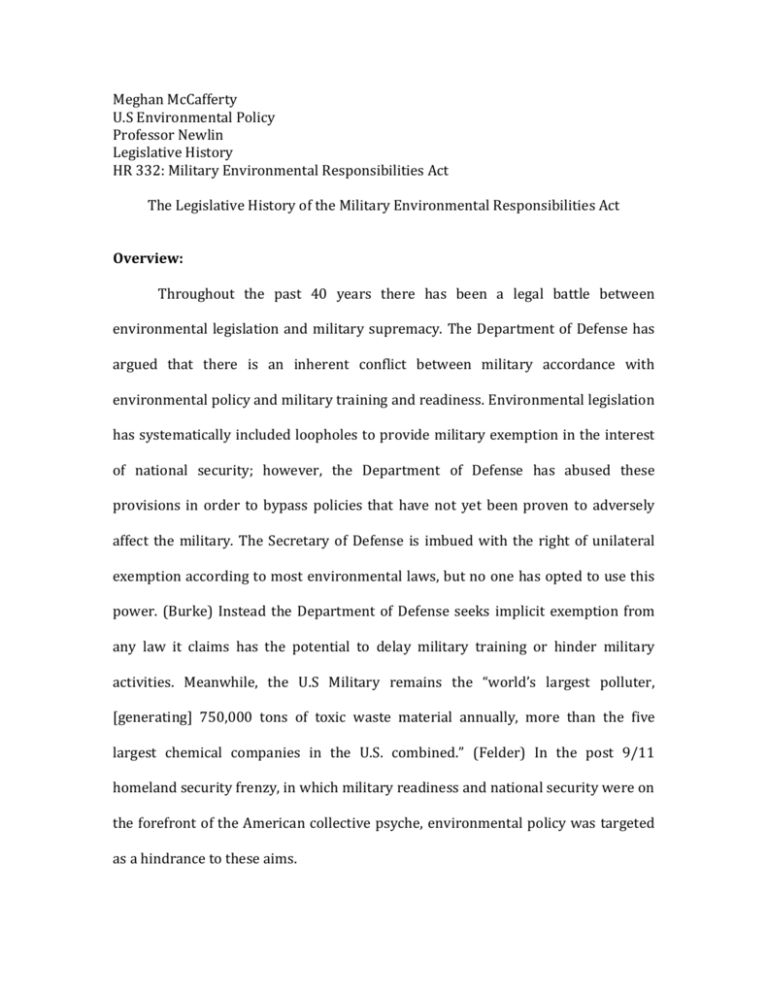Meghan McCafferty
advertisement

Meghan McCafferty U.S Environmental Policy Professor Newlin Legislative History HR 332: Military Environmental Responsibilities Act The Legislative History of the Military Environmental Responsibilities Act Overview: Throughout the past 40 years there has been a legal battle between environmental legislation and military supremacy. The Department of Defense has argued that there is an inherent conflict between military accordance with environmental policy and military training and readiness. Environmental legislation has systematically included loopholes to provide military exemption in the interest of national security; however, the Department of Defense has abused these provisions in order to bypass policies that have not yet been proven to adversely affect the military. The Secretary of Defense is imbued with the right of unilateral exemption according to most environmental laws, but no one has opted to use this power. (Burke) Instead the Department of Defense seeks implicit exemption from any law it claims has the potential to delay military training or hinder military activities. Meanwhile, the U.S Military remains the “world’s largest polluter, [generating] 750,000 tons of toxic waste material annually, more than the five largest chemical companies in the U.S. combined.” (Felder) In the post 9/11 homeland security frenzy, in which military readiness and national security were on the forefront of the American collective psyche, environmental policy was targeted as a hindrance to these aims. Major Legislation and Legal Decisions The National Environmental Policy Act of 1969 This act is the basis for future environmental policies; it instates that it is a duty of the federal government to “promote efforts which will prevent or eliminate damage to the environment and biosphere and stimulate the health and welfare of man.” (NEPA) This legislation is significant because the Military Environmental Responsibilities Act calls for the Department of Defense accordance with NEPA. This means that the military must “attain the widest range of beneficial uses of the environment without degradation, risk to health or safety, or other undesirable and unintended consequences.” (NEPA) This also includes proper and regular conduction of Environmental Impact Assessments. The Clean Water Act The precedent for military exemptions began with the Clean Water Act in 1972. The section 313 of the Clean Water Act gives the president the right to grant exemptions if he sees it as paramount to the interests of the country to “issue regulations exempting from compliance with the requirements of this section any weaponry, equipment, aircraft, vessels, vehicles, or other classes or categories of property, and access to such property, which are owned or operated by the Armed Forces of the United States (including the Coast Guard) or by the National Guard of any State and which are uniquely military in nature.” This ability of the Commander and Chief to grant exemptions to the military is reasonable when considered in the context of wartime or in a matter of national security. Migratory Bird Treaty Act In the 107th Congressional Assembly, the Department of Defense sought a temporary exemption from the Migratory Bird Treaty Act in regards to “incidental takings” of birds during military practices. Whilst they pursued the inclusion of Section 315 of the National Defense Authorization Act for FY2003 which would require the Secretary of the Interior to create regulations for issuing permits for the “incidental takings”. The Department of Defense claimed these permits were necessary in order to prevent delays in military training. Endangered Species Act In the 108th Congressional Assembly, the section 318(a) of the of the National Defense Authorization Act for FY2004 which gave the Secretary of the Interior the authority to allow military lands to be exempt from declaration as “critical habitat” under the Endangered Species Act. This amendment calls for the Secretary to consider national security before deciding on the critical lands, and the military was still subject to concordance with the remaining restrictions of the Endangered Species Act. Clean Air Act The Department of Defense also sought to amend the Clean Air Act to lessen the constraints of air pollution in regards to military actions. The Section 315 of S. 567 would allow emissions generated by military readiness activities to not be regulated by the Clean Air Act. Military Environmental Responsibilities Act This act was first introduced in the 107th Congress in the year 2001-2002 as H.R 2154. It was designed to amend Article 10 of the US Code to require the Department of Defense and other defense agencies such as the Department of Energy, The Nuclear Regulatory Committee, The Office of Naval Nuclear Reactors, and many others as designated by the President to abide by federal and state environmental laws. It was created in response to the sweeping exceptions from environmental policy being awarded to the military in the name of homeland security. The Department of Defense claimed that various environmental policies were a threat to the readiness of the military, and therefore were a threat to national security. However, the GOA released a study in 2002 that refuted the implementation of environmental policy adversely affected military readiness, and in cases when policy did interfere it was merely one of many factors that was hindering military readiness. Overall the GOA reports suggested a high overall readiness. (Beardman) The Military Environmental Responsibilities Act was reintroduced in the 110th Congress, the 111th Congress, and currently the 112th Congress. It is currently in committee and has been referred to the Subcommittee on Workforce Protections. This bill calls for equal protection of the rights of citizens who live near military bases to be free from pollutants as any other citizen. Also it requires the military to abide environmental laws at the federal and state level to the same extent as similar entities. It waives immunity granted to the Department of Defense and allows administrative enforcement against violators. The law also retracts the prohibition of the use of military appropriations funds to pay damages due to environmental policy noncompliance, and allows the use of defense funds to help restore sites designated under the Formerly Utilized Site Remedial Action Program. This bill, if enacted will protect both the environment and the health and safety of the civilian public. Sources: 1. Bearden, David M. Exemptions from Environmental Law for the Department of Defense: Background and Issues for Congress. Rep. 15 Mar. 2007. Web. 2. Burke, Marcilynn A. "Green Peace? Protecting Our National Treasures While Providing for Our National Security." William & Mary Environmental Law and Policy Review 32.3 (2008). Http://scholarship.law.wm.edu/ Wmelpr/vol32/iss3/6. Web. 3. Clean Water Act, § 313. Print. 4. Feldman, Bob. "War on the Earth." Project Censored. Mar.-Apr. 2003. Web. <http://www.ens-newswire.com/ens/jun2001/2001-06-25-03.asp>. 5. Keysar, Elizabeth, Anne Steinemann, and Ron Webster. "Intergrating Environmental Impact Assessment with Master Planning at Army Installations." (2002). Print. 6. Military Environmental Responsibilities Act, H.R. 332, 112st Cong. (2011). Print. 7. The National Environmental Protection Act, § 101 (1969). Print.








